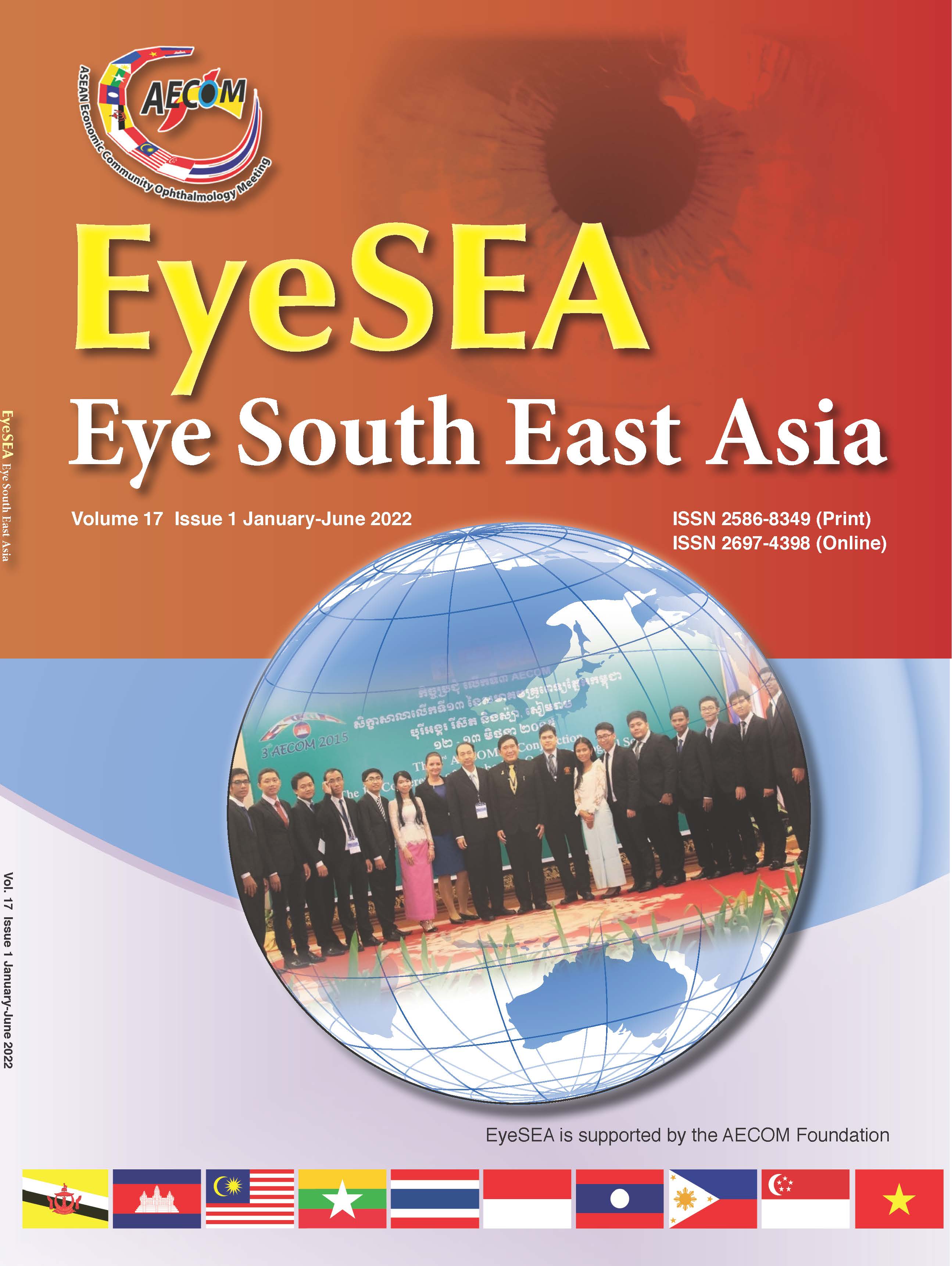Choroidal Thickness as a Biomarker of Anatomical and Functional Outcomes after Aflibercept Injections for Polypoidal Choroidal Vasculopathy
Main Article Content
Abstract
Purpose: To determine the association between choroidal thickness and response of intravitreal aflibercept injection in eyes with active polypoidal choroidal vasculopathy (PCV).
Design: Prospective cohort
Methods: We included 27 eyes with treatment-na¿ve PCV. All eyes were treated with intravitreal Aflibercept injections. Subfoveal choroidal thickness (SFCT) and Haller’s layer were measured using OCT EDI-mode at baseline and for 6 subsequent months. The ratio
between Haller’s layer and SFCT was calculated. Patients were divided into responder and non-responder groups. The association between SFCT and treatment outcome was evaluated.
Results: Eyes with thin SFCT (< 257 µm) and thick SFCT (≥ 257 µm) were demonstrated by the responder group at 83.3% and 93.3%, respectively. Neither of the groups showed a difference in the improvement of BCVA (66.7% vs 80%). Eyes with thick SFCT had a higher percentage of decreasing central macular thickness and pigment epithelial detachment compared to thin SFCT. The retreatment rate was higher for thin SFCT (58.3%). Eyes with Haller’s layer: SFCT ratio < 0.84 tended to received less injections when compared to eyes with a ratio ≥ 0.84 (3.56 vs 4.00).
Conclusion: There was no correlation between baseline SFCT and intravitreal Aflibercept injection in treatment outcomes for PCV eyes. Eyes with a ratio of Haller’s layer: SFCT less than 0.84 were likely to require fewer retreatment injections. Additional studies with
larger populations are essential to elucidate the correlation between Haller’s layer: SFCT and the treatment response of anti-VEGF injection in PCV.
Article Details

This work is licensed under a Creative Commons Attribution-NonCommercial-NoDerivatives 4.0 International License.
References
Yannuzzi LA, Sorenson J, Spaide RF, Lipson B. Idiopathic polypoidal choroidal vasculopathy (IPCV). Retina (Philadelphia, Pa) 1990;10(1):1-8.
Sasahara M, Tsujikawa A, Musashi K, Gotoh N, Otani A, Mandai M, et al. Polypoidal choroidal vasculopathy with choroidal vascular hyperpermeability. Am J Ophthalmol 2006;142(4): 601-7.
Chang YS, Kim JH, Kim JW, Lee TG, Kim CG. Optical Coherence Tomography-based Diagnosis of Polypoidal Choroidal Vasculopathy
in Korean Patients. Korean journal of ophthalmology : KJO 2016;30(3):198-205.
Kokame GT, Omizo JN, Kokame KA, Yamane ML. Differentiating Exudative Macular Degeneration and Polypoidal Choroidal
Vasculopathy Using OCT B-Scan. Ophthalmology Retina 2021;5(10):954-61.
Mori K, Gehlbach PL, Ito YN, Yone ya S. Dec rea sed a r te rial dye-filling and venous dilation in the macular choroid associated with
age-related macular degeneration. Retina (Philadelphia, Pa) 2005; 25(4):430-7.
Koh A, Lee WK, Chen LJ, Chen SJ, Hashad Y, Kim H, et al. EVEREST study: efficacy and safety of verteporfin photodynamic therapy in combination with ranibizumab or alone versus ranibizumab monotherapy in patients with symptomatic macular polypoidal
choroidal vasculopathy. Retina (Philadelphia, Pa) 2012;32(8):1453-64.
van Rijssen TJ, van Dijk EHC, Yzer S, Ohno-Matsui K, Keunen JEE, Schlingemann RO, et al. Central serous chorioretinopathy: Towards an evidence-based treatment guideline. Progress in retinal and eye research 2019;73:100770.
Chan WM, Lai TY, Lai RY, Tang EW, Liu DT, Lam DS. Safety enhanced photodynamic therapy for chronic central serous chorioretinopathy: one-year results of a prospective study. Retina (Philadelphia, Pa) 2008;28(1):85-93.
Lee WK, Iida T, Ogura Y, Chen SJ, Wong TY, Mitchell P, et al. Efficacy and Safety of Intravitreal Aflibercept for Polypoidal Choroidal
Vasculopathy in the PLANET Study: A Randomized Clinical Trial. JAMA ophthalmology 2018;136(7):786-93.
Kokame GT, Yeung L, Lai JC. Continuous anti-VEGF treatment with ranibizumab for polypoidal choroidal vasculopathy: 6-month
resul ts. The Bri tish journal of ophthalmology 2010;94(3):297-301.
Kang HM, Kwon HJ, Yi JH, Lee CS, Lee SC. Subfoveal choroidal thickness as a potential predictor of visual outcome and treatment response after intravitreal ranibizumab injections for typical exudative age-related macular degeneration. Am J Ophthalmol 2014;
(5):1013-21.
Shin JY, Kwon KY, Byeon SH. Associa tion be tween choroidal thickness and the response to intravitreal ranibizumab injection in
age-related macular degeneration. Acta Eye South East Asia Vol.17 Issue 1 2022 39 ophthalmologica 2015;93(6):524-32.
Maruko I, Iida T, Oyamada H, Sugano Y, Ojima A, Sekiryu T. Choroidal thickness changes after intravitreal ranibizumab and photodynamic therapy in recurrent polypoidal choroidal vasculopathy. Am J Ophthalmol 2013;156(3):548-56.
Lee WK, Baek J, Dansingani KK, Lee JH, Freund KB. Choroidal morphology in eyes with polypoidal choroidal vasculopathy and normal
or subnormal subfoveal choroidal thickness. Retina (Philadelphia, Pa) 2016;36 Suppl 1:S73-s82.
Gupta P, Ting DSW, Thakku SG, Wong TY, Cheng CY, Wong E, et al. Detailed characterization of choroidal morphologic and vascular
features in age-related macular degeneration and polypoidal choroidal vasculopathy. Retina (Philadelphia, Pa) 2017;37(12):2269-80.
Lee K, Park JH, Park YG, Park YH. Analysis of choroidal thickness and vascularity in patients with unilateral polypoidal choroidal vasculopathy. Graefe’s archive for clinical and experimental ophthalmology=Albrech t von Grae fes Archiv fur klinische und experimentelle Ophthalmologie 2020;258(6):1157-64.
Kim YH, Lee B, Kang E, Oh J. Choroidal thickness profile and clinical outcomes in eyes with polypoidal choroidal vasculopathy. Graefe’s archive for clinical and experimental ophthalmology=Albrecht von Graefes Archiv fur klinische und experimentelle
Ophthalmologie 2021.
Jordan-Yu JM, Chong Teo KY, Chakravarthy U, Gan A, Sim Tan AC, Cheong KX, et al. Polypoidal choroidal vasculopathy features vary
according to sub-foveal choroidal thickness. Retina (Philadelphia, Pa) 2020.
Liu ZY, Li B, Xia S, Chen YX. Analysis of choroidal morphology and comparison of imaging findings of subtypes of polypoidal choroidal vasculopathy: a new classification system. International journal of ophthalmology 2020;13(5):731-6.
Koizumi H, Yamagishi T, Yamazaki T, Kinoshita S. Relationship between clinical characteristics of polypoidal choroidal vasculopathy and choroidal vascular hyperpermeability. Am J Ophthalmol 2013;155(2):305-13 e1.
Kim H, Lee SC, Kwon KY, Lee JH, Koh HJ, Byeon SH, et al. Subfoveal choroidal thickness as a predictor of treatment response to anti-vascular endothelial growth factor therapy for polypoidal choroidal vasculopathy. Graefe’s archive for clinical and experimental ophthalmology = Albrecht von Graefes Archiv fur klinische und experime n telle Ophthalmologie 2016;254(8):1497-503.
Sakurada Y, Sugiyama A, Tanabe N, Kikushima W, Kume A, Iijima H. Choroidal thickness as a prognostic factor of photodynamic therapy with aflibercept or ranibizumab for polypoidal choroidal vasculopathy. Retina (Philadelphia, Pa) 2017;37(10):1866-72.


